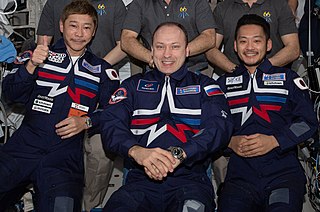This article needs to be updated.(May 2023) |
The following is a list of space races, meaning competitions or rivalries between states or companies involving the development of space travel.
This article needs to be updated.(May 2023) |
The following is a list of space races, meaning competitions or rivalries between states or companies involving the development of space travel.

Human spaceflight is spaceflight with a crew or passengers aboard a spacecraft, often with the spacecraft being operated directly by the onboard human crew. Spacecraft can also be remotely operated from ground stations on Earth, or autonomously, without any direct human involvement. People trained for spaceflight are called astronauts, cosmonauts (Russian), or taikonauts (Chinese); and non-professionals are referred to as spaceflight participants or spacefarers.

Space tourism is human space travel for recreational purposes. There are several different types of space tourism, including orbital, suborbital and lunar space tourism.

Spaceflight is an application of astronautics to fly objects, usually spacecraft, into or through outer space, either with or without humans on board. Most spaceflight is uncrewed and conducted mainly with spacecraft such as satellites in orbit around Earth, but also includes space probes for flights beyond Earth orbit. Such spaceflight operate either by telerobotic or autonomous control. The more complex human spaceflight has been pursued soon after the first orbital satellites and has reached the Moon and permanent human presence in space around Earth, particularly with the use of space stations. Human spaceflight programs include the Soyuz, Shenzhou, the past Apollo Moon landing and the Space Shuttle programs. Other current spaceflight are conducted to the International Space Station and to China's Tiangong Space Station.
Human spaceflight programs have been conducted, started, or planned by multiple countries and companies. Until the 21st century, human spaceflight programs were sponsored exclusively by governments, through either the military or civilian space agencies. With the launch of the privately funded SpaceShipOne in 2004, a new category of human spaceflight programs – commercial human spaceflight – arrived. By the end of 2022, three countries and one private company (SpaceX) had successfully launched humans to Earth orbit, and two private companies had launched humans on a suborbital trajectory.

The Ansari X Prize was a space competition in which the X Prize Foundation offered a US$10,000,000 prize for the first non-government organization to launch a reusable crewed spacecraft into space twice within two weeks. It was modeled after early 20th-century aviation prizes, and aimed to spur development of low-cost spaceflight.

The Canadian Arrow was a privately funded, early-2000s rocket and space tourism project concept founded by London, Ontario, Canada entrepreneurs Geoff Sheerin, Dan McKibbon and Chris Corke. The project's objective was to take the first civilians into space, on a vertical sub-orbital spaceflight reaching an altitude of 112 km.
The Centennial Challenges are NASA space competition inducement prize contests for non-government-funded technological achievements by American teams.

The Space Age is a period encompassing the activities related to the space race, space exploration, space technology, and the cultural developments influenced by these events, beginning with the launch of Sputnik 1 on October 4, 1957, and continuing to the present.

The Vision for Space Exploration (VSE) was a plan for space exploration announced on January 14, 2004 by President George W. Bush. It was conceived as a response to the Space Shuttle Columbia disaster, the state of human spaceflight at NASA, and as a way to regain public enthusiasm for space exploration.

Tier One was a Scaled Composites' 1990s–2004 program of suborbital human spaceflight using the reusable spacecraft SpaceShipOne and its launcher White Knight. The craft was designed by Burt Rutan, and the project was funded 20 million US Dollars by Paul Allen. In 2004 it made the first privately funded human spaceflight and won the 10 million US Dollars Ansari X Prize for the first non-governmental reusable crewed spacecraft.

Private spaceflight refers to spaceflight activities undertaken by non-governmental entities, such as corporations, individuals, or non-profit organizations. This contrasts with public spaceflight, which is traditionally conducted by government agencies like NASA, ESA, or JAXA.
Bigelow Aerospace was an American space design and manufacturing company which closed its doors in 2020. It was an aeronautics and outer space technology company which manufactured and developed expandable space station modules. Bigelow Aerospace was founded by Robert Bigelow in 1998, and was based in North Las Vegas, Nevada. It was funded in large part by the profit Bigelow gained through his ownership of the hotel chain, Budget Suites of America.

Dragon is a family of spacecraft developed and produced by American private space transportation company SpaceX. The first family member, later named Dragon 1, flew 23 cargo missions to the ISS between 2010 and 2020 before retiring. This version, not designed to carry astronauts, was funded by NASA with $396 million awarded through the Commercial Orbital Transportation Services (COTS) program, with SpaceX announced as a winner of the first round of funding on August 18, 2006.

The X Prize Cup is a two-day air and space exposition which was the result of a partnership between the X Prize Foundation and the State of New Mexico that began in 2004 when the Ansari X-Prize was held. This led to plans to build the world's first true rocket festival. Three X-Prize Cups have been held: in 2005, 2006 and 2007. Each X Prize Cup hosts different events and demonstrations, such as rocket-powered bicycles, rocket jet packs; but particularly notable are the Lunar Lander Challenge and the Space Elevator Games. 85,000 visitors attended the 2007 X Prize Cup. Although there was no X Prize Cup in 2009, there was a Lunar Lander Challenge.

Spaceflight began in the 20th century following theoretical and practical breakthroughs by Konstantin Tsiolkovsky, Robert H. Goddard, and Hermann Oberth, each of whom published works proposing rockets as the means for spaceflight. The first successful large-scale rocket programs were initiated in Nazi Germany by Wernher von Braun. The Soviet Union took the lead in the post-war Space Race, launching the first satellite, the first animal, the first human and the first woman into orbit. The United States caught up with, and then passed, their Soviet rivals during the mid-1960s, landing the first men on the Moon in 1969. In the same period, France, the United Kingdom, Japan and China were concurrently developing more limited launch capabilities.

The following outline is provided as an overview of and topical guide to space exploration.
A space competition is an inducement prize contest offering a prize to be given to the first competitor who demonstrates a space vehicle, or a space exploration apparatus, which meets a set of pre-established criteria. It spurs pioneering development in private spaceflight.

SpaceIL is an Israeli organization, established in 2011, that competed in the Google Lunar X Prize (GLXP) contest to land a spacecraft on the Moon.

Jim Cantrell is an American entrepreneur, mechanical engineer and road racer. He is the CEO and co-founder of Phantom Space Corporation, which aims to build space transportation technology. After working at the French Space Agency CNES and the NASA Jet Propulsion Lab, he worked as an independent consultant to aerospace companies for fifteen years and was on the founding teams of SpaceX and Moon Express. Cantrell was SpaceX's first vice president of business development and Elon Musk's industry mentor when SpaceX launched in 2002.